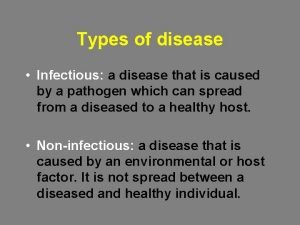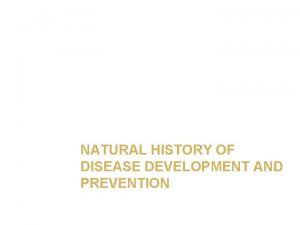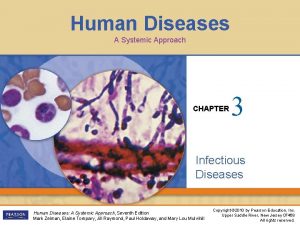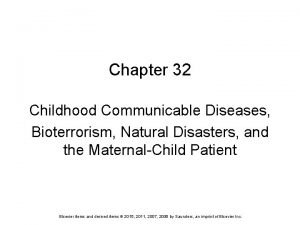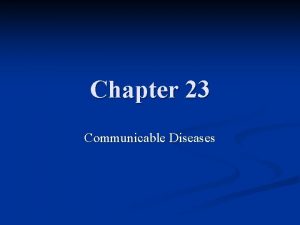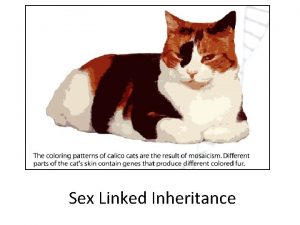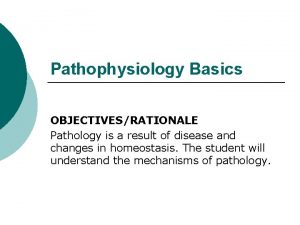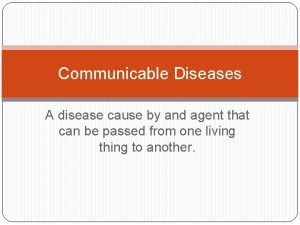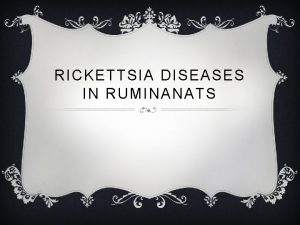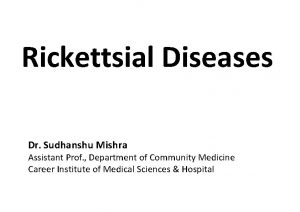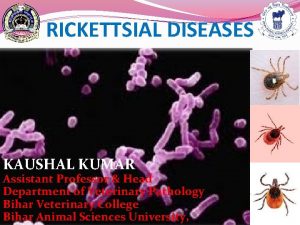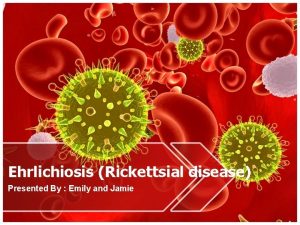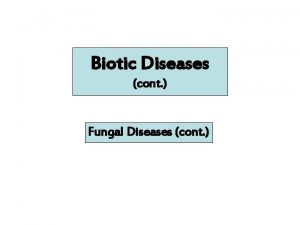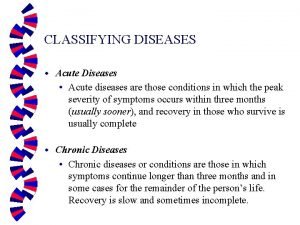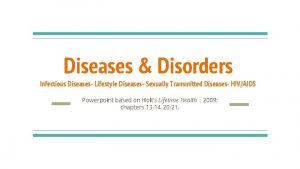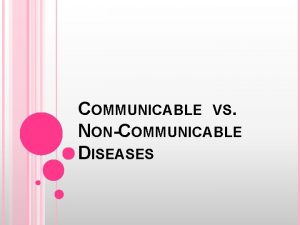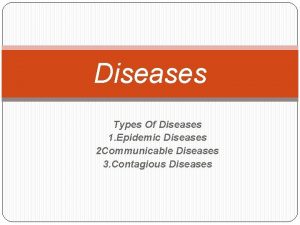Rickettsial Diseases or Id rather die of one









































































- Slides: 73

Rickettsial Diseases or I’d rather die of one than learn them all ID/Med Micro Half Day November 9, 2016 Isaac I. Bogoch, MD, MS, FRCPC, DTM&H Divisions of Infectious Diseases and General Internal Medicine Toronto General Hospital

What ID topics do ID docs know the least about? § § Rickettsial diseases Atypical mycobacterial infections Some topics in Trop Med What else?

“Doxycycline deficient state” “Never let a febrile patient die without a trial of doxycycline” Not entirely helpful, not really clinically useful, kind of clinically lazy, but you get the point

Roadmap § Microbiology and Pathogenesis § An approach to these Rickettsial infections § Clinical and epidemiology of select Rickettsial infections § Diagnosis § Treatment § Prevention

Microbiology and Pathogenesis § § § Historically defined by their phenotype Very small Obligate intracellular Gram negative Non-motile Non-spore forming

Microbiology and Pathogenesis § Pleomorphic – can be many shapes § 0. 1 – 10 microns long § Cocci § Bacilli § Threadlike

Microbiology and Pathogenesis § Tropism for vascular endothelial cells § Infection may increase vascular permeability § Responsible for the rash that is common in many infections § Can lead to DIC § Rare but occurs in severe Rickettsial infections

(Very) Brief History § § § Howard Taylor Ricketts 1871 – 1910 Discovered RMSF transmitted by ticks Prone to self-experimentation 1910 he isolated a strain of Murine typhus from an outbreak in Mexico – then died of the disease

Differential diagnosis § Fever, Rash, Headache, Myalgia § Bacterial meningitis § § § § Or disseminated Neisseria Leptospirosis Measles Dengue West Nile Virus – encephalitis Acute HIV Acute mononucleosis-like syndrome Occasionally influenza § Eschar § § § Bites – spider Trauma Cutaneous anthrax Tularemia Fungal – endemic mycosis § Non-infectious thoughts for systemic symptoms § § TTP Drug hypersensitivity – especially as rash is on day 3 -5

An approach to Rickettsial infections

An Approach § Illnesses in the Rickettsial genus from 3 major “biogroups” § Remember that this is constantly growing and getting re-defined § There additional “Rickettsial-like” infections that are phylogenically related and may have similar clinical presentations

Rickettsial illnesses Spotted Fever biogroup Typhus biogroup Scrub typhus biogroup Many diseases Epidemic typhus R. prowazekii Orientia tsutsugamushi RMSF R. rickettsii Other related illnesses Bartonella spp. Anaplasma Murine typhus R. typhi Ehrlichia Q fever

Terminology § Typhus § Greek for hazy or smoky § Describes mental status associated with infection § Typhoid § Greek for “typhus-like”

Rickettsial illnesses Spotted Fever biogroup Many diseases RMSF R. rickettsii Moraine Lake, Alberta

Spotted Fever Biogroup § § Many pathogens Exist worldwide except Antarctica Each has a unique ecology All are arthropod borne § Most are tick borne with only a couple of exceptions § Overlapping but not identical syndromes! § We will discuss the big ones

Spotted Fever Biogroup § Most will cause some combination of § § § Fever Headache Myalgia Some will have one or more eschar Many will have a rash Illness may be mild to life-threatening

Rocky Mountain Spotted Fever § R. rickettsii § Found in: Canada, USA, Mexico, Central-South America § Other names § § Brazilian spotted fever Febre maculosa São Paulo exanthematic typhus Minas Gerais exanthematic typhus

Rocky Mountain Spotted Fever § Transmitted by multiple tick species § Dermacentor variabilis (American dog tick - USA) § Dermacentor andersoni (Rocky Mountain wood tick USA) § Amblyomma cajennense (Central-South America) § Rhipicephalus sanguineus (Mexico)

Rocky Mountain Spotted Fever

Rocky Mountain Spotted Fever

Rocky Mountain Spotted Fever § Most do not recall tick bite § Tick needs to be attached for >6 hours for transmission § Symptoms occur after 2 -14 day incubation period § Poor outcomes with antibiotic delay § “Failure to consider” diagnosis a problem

Rocky Mountain Spotted Fever § Fever, headache, myalgia – common § Rash in ~90% § Starts day 3 -5, so may develop when already in medical care § Blanching erythematous rash § Macules turn to petichial, or may just start petichial § Begins at extremities and moves toward trunk § Commonly affects palms and soles in late disease

Rocky Mountain Spotted Fever CDC Redbook - American Academy of Pediatrics

Rocky Mountain Spotted Fever § Petichiae may be pruritic § Petichiae may form ecchymoses – bleeding into the skin § Eschars at the site of tick bite very rare § ~10% of cases do not have rash § Poor outcome as RMSF not considered

Rocky Mountain Spotted Fever § Complications § § § Encephalitis Seizures Multisystem organ failure Arrhythmias ARDS DIC

Rocky Mountain Spotted Fever § § Thrombocytopenia Hyponatremia Elevated LFTs CSF <100 wbc’s § Lymphocytic predominance § Confirmation § § § Serology - retrospective Staining of skin biopsy via immunofluorescence Cannot be cultured § Bacterial meningitis § § § § § Or disseminated Neisseria Leptospirosis Measles Dengue West Nile Virus – encephalitis Acute HIV Acute mononucleosis-like syndrome Ehrlichiosis/Anaplasmosis TTP Drug hypersensitivity – especially as rash is on day 3 -5

Rocky Mountain Spotted Fever § “Doxycycline is the first line treatment for adults and children of all ages and should be initiated immediately whenever RMSF is suspected” CDC, 2016

Rocky Mountain Spotted Fever “Use of antibiotics other than doxycycline is associated with a higher risk of fatal outcome. Treatment is most effective at preventing death if doxycycline is started in the first 5 days of symptoms. Therefore, treatment must be based on clinical suspicion alone and should always begin before laboratory results return or symptoms of severe disease, such as petechiae, develop” CDC, 2016

Rocky Mountain Spotted Fever § Chloramphenicol is the only alternative agent for RMSF § Very difficult to obtain in N. America on short notice § Severe allergy to doxycycline § May use in some pregnant women? § Associated with Gray Syndrome in fetus – accumulation of toxic metabolites: ashen colour, cardio-respiratory collapse § Fatal aplastic anemia in 1: 25000 - 1: 40000 § may occur days to months after use

Rickettsial illnesses Spotted Fever biogroup Many diseases RMSF R. rickettsii Other spotted fever biogroup illnesses beyond RMSF

African Tick Bite Fever § R. africae § Most common non-malarial fever in travelers from southern Africa § ~5 day incubation period § Fever, headache, myalgia § Eschar is pathognomonic with compatible epidemiology § “Tache noire”

Lancet ID, 2003

South Africa Malawi “Tache noire” Mozambique

Rickettsialpox § § § § R. akari From the bite of a mite (not tick!) Russia, a few cases in NYC, Africa, South Europe 7 -10 day incubation Fever, headache, myalgia Eschar common Maculapapular rash common § Some macules become vesicular - appears like varicella

Mediterranean Spotted Fever § “Boutonneuse fever” § R. conorii § Around Mediterranean, southern Europe, India, Africa § Fever, headache, myalgia § Eschar common § Typically less severe than RMSF

Rickettsia parkeri infection § § § R. parkeri USA and all over Americas Fever, headache, myalgia One or more eschars Typically more mild than RMSF May have more GI symptoms than RMSF

Rickettsia parkeri infection Green - Amblyomma americanum ticks distribution Red/Yellow - confirmed and suspected cases http: //cdc. gov/eid/article/15/9/09 -0330 -f 1

Queensland tick tyhphus § § § R. australis East coast of Australia Only 1 fatal case documented Eschar in 50% Maculopapular rash, in some cases vesicular and confused with varicella

Japanese Spotted Fever § § § R. japonica Japan and Thailand Eschar in >90% All with fever, headache, myalgia and rash Similar to RMSF

Disease Species Geographic Distribution Clinical Symptoms Rickettsiosis Rickettsia aeschlimannii Africa, Mediterranean region Fever, eschar, maculopapular rash African tick- bite fever Rickettsia africae Sub-Saharan Africa, West Indies Fever, eschar, maculopapular rash Queensland tick typhus Rickettsia australis Australia, Tasmania Fever, eschar, regional adenopathy, rash on extremities Mediterranean spotted fever or Boutonneuse fever Rickettsia conorii‡ Mediterranean region and Africa to Indian subcontinent Fever, eschar (usually single), regional adenopathy, maculopapular rash on extremities Far eastern spotted fever Rickettsia heilongjiangensis Northern China, Eastern Asia Fever, eschar, maculopapular rash, regional adenopathy Aneruptive fever Rickettsia helvetica Central and northern Europe Fever, headache, myalgia www. cdc. gov/otherspottedfever/

Disease Species Geographic Distribution Clinical Symptoms Flinders Island spotted fever, Thai tick typhus Rickettsia honei Australia, Thailand Mild spotted fever, eschar and adenopathy are rare Japanese spotted fever Rickettsia japonica Japan Fever, eschar(s), regional adenopathy, rash on extremities Australia Fever, eschar, maculopapular or vesicular rash, adenopathy France, Greece, Spain, Portugal, Switzerland, Sicily, Central Africa and Mali Fever, maculopapular rash, necrotic eschar Australian spotted fever Rickettsia massiliae rickettsioses Rickettsia marmionii subspecies Rickettsia massiliae Rocky Mountain spotted fever, febre maculosa, Sao Paulo exanthematic typhus, Minas Gerais exanthematic typhus, Brazillian spotted fever Rickettsia rickettsii North, Central and South America Fever, headache, abdominal pain, maculopapular rash progressing into papular or petechial rash (generally originating on extremities) North Asian tick typhus, Siberian tick typhus Rickettisa sibirica Broadly distributed through north Asia Fever, eschar(s), regional adenopathy, maculopapular rash Lymphangitis associated rickettsiosis Rickettsia sibirica mongolotimonae Southern France, Portugal, China, Sub-saharan Africa Fever, multiple eschars, regional adenopathy and lymphangitis, maculopapular rash Tick-borne lymphadenopathy (TIBOLA), Dermacentor-borne necrosis and lymphadenopathy (DEBONEL) Rickettsia slovaca Southern and eastern Europe, Asia Necrosis erythema, cervical lymphadenopathy and enlarged lymph nodes, rare maculopapular rash

Rickettsial illnesses Typhus biogroup Epidemic typhus R. prowazekii Murine typhus R. typhi

Epidemic typhus § R. prowazekii § camp fever, jail fever, ship fever, famine fever, putrid fever § Historically deadly disease th § Killed >10 million in past 20 Century § Outbreaks associated with war, famine, refugee camps, crowding and extreme poverty § Under diagnosed

Epidemic tyhphus - epidemiology § Transmitted by § Body louse - Pediculosis humanus*** § Head louse - P. humanus capitis § Found in flying squirrels in USA, and in squirrel fleas and lice § Body louse lives on clothes, eggs laid on clothes § Transmission from louse bite, or from louse feces on clothes rubbed into skin lesion

Epidemic typhus - epidemiology § Today, cases in § Africa – war torn regions § Mountainous regions of Algeria § Terminology § “Epidemic typhus” related to louse § “Sylvatic typhus” or “Sylvatic epidemic typhus” related to flying squirrels § All are R. prowazekii infections

Kingston, Ontario

Epidemic typhus - clinical § Acute syndrome § 7 - 14 days after exposure § 10 - 40% mortality without antibiotic use § Late syndrome § Brill-Zinsser disease § 1 - 5 decades after infection

Epidemic typhus - Acute § Fever, headache, myalgia – almost everyone § Rash starts within 3 -5 days on trunk to limbs § Maculopapular § 15 -50% will have petichial rash § Rash may be even less common in sylvatic typhus § CNS: confusion, obtundation common, seizures rare § Labs: thrombocytopenia, elevated LFTs

Epidemic typhus: Brill-Zinsser disease § Recrudescence of illness years-decades after infection § Can occur in the elderly § Symptoms are identical § Syndrome is typically more mild § Rash is typically more mild § Treatment: doxycycline

Epidemic typhus – Dx and Rx § Diagnosis § Serology – mainstay but impractical § Clinical suspicion § Treatment § Supportive care § Doxycycline – even single doses of 200 mg may be effective § Chloramphenicol

Murine typhus § § Rickettsia typhi Other names: Endemic typhus, Flea borne typhus Transmitted by fleas Urban areas commonly in tropical and subtropical seaboard centers § USA: suburban cases found § Much more mild illness than Epidemic typhus

Murine typhus - epidemiology § Transmitted by fleas worldwide § Typically fleas that feed on rats § In USA, fleas that feed on cats and opossums implicated § Texas and California § Reservoir: Rats, cats, opossums § Fleas preferentially feed on host, humans are accidental hosts if preferred host not around

Murine typhus - clinical § § 8 -14 day incubation period Abrupt onset fever, headache, myalgia Children commonly have GI symptoms Maculopapular rash in most (>80%) but may be hard to see in those with darker skin § Rare complications § Confusion, pulmonary edema, meningitis

Civen, Clin Infect Dis, 2008

Murine typhus – Dx and Rx § Diagnosis § Serology – mainstay but impractical § PCR if available § Clinical suspicion § Treatment § Doxycycline – even single doses of 200 mg may be effective § Chloramphenicol – treatment failures reported

Rickettsial illnesses Scrub typhus biogroup Orientia tsutsugamushi

Scrub typhus § § § Previously Rickettsia tsutsugamushi Now Orientia tsutsugamushi Common febrile illness in Asia/Pacific Mild-severe illness Known for centuries, but most data comes from WWII as it was common in soldiers

Scrub typhus - epidemiology § Vast majority of cases in Asia/Pacific § Korea, China, Japan, Pakistan, India, Thailand, Malaysia, and northern Australia § 3 cases found on an island of the coast of Chile! § Mostly a rural infection § Increasingly in suburban areas

Scrub typhus - epidemiology § From the bite of larval mites (aka “chiggers”) § Leptotrombidium genus § Can transmit infection tranovarially – so can pass infection on to successive generations § Very focal disease where vector lives § “Mite islands” as small as a few square feet of vegetation

Scrub typhus - clinical § § § Incubation period 6 -16 days Acute febrile illness Fever, myalgia, headache Eschar in >50% Rash: maculopapular in 50%, rarely pruritic, chest limbs § Mild illness to MSOF § Complications: delirium, myocarditis, pneumonitis

Scrub typhus - clinical § Other findings: § Cough is common – may have pneumonitis in 45% § Relative bradycardia § GI symptoms: nausea and vomiting +/- diarrhea in >50% § Labs: thrombocytopenia and elevated LFTs common § Diagnosis: § Serology, biopsy of an eschar with EIA

Scrub typhus - treatment § Doxycycline 100 mg po BID x 3 -7 days § Mostly susceptible, but some reports of resistance § Azithromycin 500 mg po x 1 § successful in mild illness § Pregnancy with mild illness? Azithro


NEJM, 2016

Rickettsial illnesses Other related illnesses Bartonella spp. Anaplasma Ehrlichia Q fever

Human ehrlichiosis and anaplasmosis § Many species worldwide § The two most important (to date): § Ehrlichia chaffeensis § human monocytic ehrlichiosis, or “HME” § Anaplasma phagocytophilum § human granulocytic anaplasmosis, or “HGA”

Human ehrlichiosis and anaplasmosis § E. chaffeensis § Lone start tick (Amblyomma americanum) main vector, but there are others § A. phagocytophilum § Ixodes scapularis is common vector § Also transmits Lyme and Babesia § 5 -20% of ticks are co-infected

Human ehrlichiosis and anaplasmosis § E. chaffeensis reservoir: § White tailed deer § A. phagocytophilum reservoir: § Other deer, white footed mouse

CDC, 2016

Human ehrlichiosis and anaplasmosis § Wide spectrum of disease § Asymptomatic to severely ill § § 5 -18 day incubation period Most with fever, myalgia, headache Rash is rare Leukopenia and thrombocytopenia is common

Human ehrlichiosis and anaplasmosis § Diagnosis is with serology and PCR § PCR not standardized, but common and validated in many high-burden areas § Serology may not distinguish between E. chaffeensis and A. phagocytophilum § Remember to screen for Lyme and Babesia coinfection § Blood film or PCR for Babesia, serology for Lyme

Human ehrlichiosis and anaplasmosis § Treatment is: § Doxycycline § Chloramphenicol § Rifampin alone has been used successfully § May be used in less severe cases – pregnancy, children <45 kg § 2 -10% mortality if untreated § Likely no lifelong immunity

Rickettsial illnesses Spotted Fever biogroup Typhus biogroup Scrub typhus biogroup Many diseases Epidemic typhus R. prowazekii Orientia tsutsugamushi RMSF R. rickettsii Other related illnesses Bartonella spp. Anaplasma Murine typhus R. typhi Ehrlichia Q fever
 Die mier en die sprinkaan fabel pdf
Die mier en die sprinkaan fabel pdf Rather than build a subgraph one vertex at a time
Rather than build a subgraph one vertex at a time A grosso has a group of soloists rather
A grosso has a group of soloists rather My father works as ___ engineer. *
My father works as ___ engineer. * Die kinder verbringen die ferien
Die kinder verbringen die ferien Je höher die berge desto schöner die gams
Je höher die berge desto schöner die gams Tipes doelwitte
Tipes doelwitte South park college know it all hippies
South park college know it all hippies Die einde van die koue oorlog 1989
Die einde van die koue oorlog 1989 Ek glo in god die vader
Ek glo in god die vader Die pad van waarheid tot die lewe
Die pad van waarheid tot die lewe Lydende en bedrywende vorm graad 9
Lydende en bedrywende vorm graad 9 Die europäer verteilen die welt
Die europäer verteilen die welt Jys die stem in die stilte wat agterbly
Jys die stem in die stilte wat agterbly Rosen die ich an dich verschenke
Rosen die ich an dich verschenke Druppel die de emmer doet overlopen
Druppel die de emmer doet overlopen Wenn die vorhaut zuhaut
Wenn die vorhaut zuhaut Pad van waarheid tot die lewe
Pad van waarheid tot die lewe Die pad van waarheid tot die lewe
Die pad van waarheid tot die lewe Voorbeelde van voegwoorde
Voorbeelde van voegwoorde One god one empire one religion
One god one empire one religion One one one little puppy run
One one one little puppy run One king one law one faith
One king one law one faith Byzantine definition
Byzantine definition One team one plan one goal
One team one plan one goal See one do one teach one
See one do one teach one One price policy
One price policy One face one voice one habit and two persons
One face one voice one habit and two persons Studiendekanat uni bonn
Studiendekanat uni bonn Asean tourism strategic plan
Asean tourism strategic plan Graphic organizer with the aims of la liga filipina
Graphic organizer with the aims of la liga filipina Different types of diseases
Different types of diseases Quality definition by quality gurus
Quality definition by quality gurus Protein deficiency diseases
Protein deficiency diseases Natural history of disease
Natural history of disease Lifestyle modern
Lifestyle modern Major nutritional deficiency diseases in emergencies
Major nutritional deficiency diseases in emergencies Maxillofacial area inflammatory diseases
Maxillofacial area inflammatory diseases Iceberg phenomenon of disease
Iceberg phenomenon of disease Human diseases a systemic approach
Human diseases a systemic approach Venn diagram of communicable and noncommunicable diseases
Venn diagram of communicable and noncommunicable diseases Chapter 24 lesson 1 sexually transmitted diseases
Chapter 24 lesson 1 sexually transmitted diseases Periradicular tissue definition
Periradicular tissue definition Section 19-3 diseases caused by bacteria and viruses
Section 19-3 diseases caused by bacteria and viruses Chapter 8 skin disorders and diseases
Chapter 8 skin disorders and diseases Chapter 6 musculoskeletal system diseases and disorders
Chapter 6 musculoskeletal system diseases and disorders Chapter 32 childhood communicable diseases bioterrorism
Chapter 32 childhood communicable diseases bioterrorism Chapter 24 sexually transmitted diseases and hiv/aids
Chapter 24 sexually transmitted diseases and hiv/aids Chapter 23 lesson 1 understanding communicable diseases
Chapter 23 lesson 1 understanding communicable diseases Chapter 22 genetics and genetically linked diseases
Chapter 22 genetics and genetically linked diseases Chapter 21 mental health diseases and disorders
Chapter 21 mental health diseases and disorders Chapter 17 reproductive system diseases and disorders
Chapter 17 reproductive system diseases and disorders Chapter 15 nervous system diseases and disorders
Chapter 15 nervous system diseases and disorders Milady nail diseases and disorders
Milady nail diseases and disorders Chapter 10 lymphatic system diseases and disorders
Chapter 10 lymphatic system diseases and disorders X linked diseases
X linked diseases Whats sex linked
Whats sex linked Perianal pruritus
Perianal pruritus Hyperglyceremia
Hyperglyceremia Nutritional diseases
Nutritional diseases Nutritional diseases
Nutritional diseases King of diseases
King of diseases Normal gingiva in child
Normal gingiva in child Non communicable diseases
Non communicable diseases Columbian exchange restaurant names
Columbian exchange restaurant names Chapter 8 skin disorders and diseases
Chapter 8 skin disorders and diseases Milady chapter 10 review questions
Milady chapter 10 review questions Diseases spread by columbian exchange
Diseases spread by columbian exchange Sti std
Sti std What causes genetic diseases
What causes genetic diseases Certain infectious and parasitic diseases
Certain infectious and parasitic diseases Sexually transmitted diseases
Sexually transmitted diseases Examples of communicable diseases
Examples of communicable diseases Chapter 8 cardiovascular system
Chapter 8 cardiovascular system































